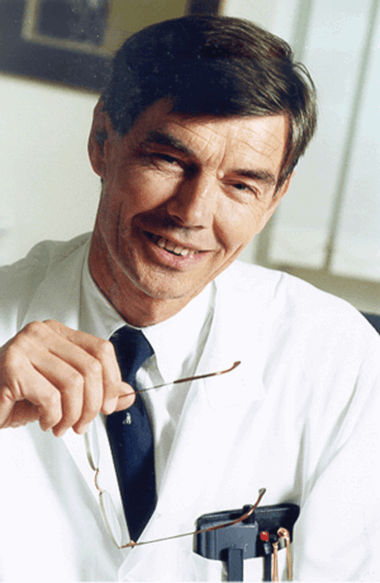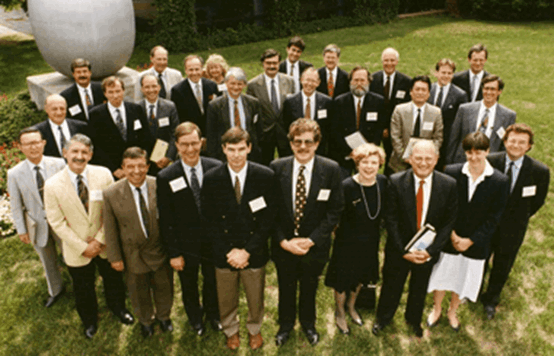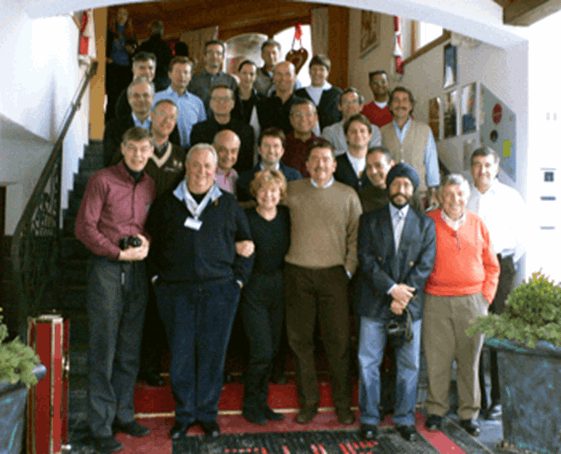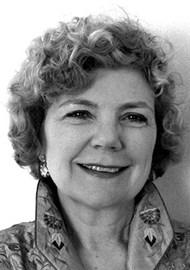It is no exaggeration to say that functional endoscopic sinus surgery would not exist in its current form without Heinz Stammberger. Prof Valerie Lund traces the development of this relatively recent surgical technique.
In the early 1980s, a happy combination of an eminent ENT professor’s interest in nasal anatomy and physiology (Walter Messerklinger in Graz, Austria) and the collaboration of a professor of optical physics (Harold Hopkins in Reading, UK) with an instrument manufacturer (Karl Storz in Tuttlingen, Germany) on the development of the modern endoscope had a profound and game-changing effect.
Exposed to the experiments of his esteemed boss and already an adept sinus surgeon, the young Heinz Stammberger realised the potential advantages that the new technology could provide in managing sinonasal disease.

Figure 1. Professor Heinz Stammberger.
Whilst Messerklinger mainly utilised his endoscope to visualise mucociliary clearance, Heinz applied it surgically, initially to chronic rhinosinusitis [1] and then to a wide range of sinonasal conditions – advocating a more conservative approach, facilitated by the improved endoscopic visualisation and utilising the new refined instrumentation that accompanied the endoscope development. The rest, as they say, is history!
I first heard Heinz speak in Japan and confess to some initial scepticism but was rapidly won over by his genuine enthusiasm, his extraordinary understanding of the ‘new’ detailed anatomy, his superb linguistic ability and the fact that this really seemed to offer a solution to a common chronic problem which pre-existing operations failed to help.

Figure 2. A consensus group of endoscopic surgeons who met in Princeton, USA, in
July 1993 following the International Advanced Sinus Symposium, Philadelphia, July 1993.
“He worked unceasingly through his surgical skill, charismatic lecturing, publications and many hundreds of dissection courses to promote the endoscopic technique worldwide”
Heinz put Graz on the map through his biannual courses which he started in 1986 and which I and many thousands attended. His lectures in the USA on behalf of Messerklinger took the technique across the Atlantic [2] (see Figure 2) and once he assumed the mantel of Professor and Head of Department in Graz in 1988, after Messerklinger’s retirement, he worked unceasingly through his surgical skill, charismatic lecturing, publications and many hundreds of dissection courses to promote the endoscopic technique worldwide. Our annual endoscopic course in London was a regular beneficiary of his talents.
Endoscopic sinonasal diagnosis and surgery swept the world, largely fuelled by the vastly enhanced visualisation, precise surgical techniques and potentially reduced morbidity associated with improved outcomes. In 1991 Heinz published his first book, Functional Endoscopic Sinus Surgery [3], which was the ‘bible’ for the technique and, from the late 1980s to the present day, no conference or congress has been complete without multiple sessions on the philosophy and practice of endoscopic surgery, to say nothing of the innumerable international, national and local meetings devoted entirely to the subject.
“It is interesting to speculate if the more conservative endoscopic approach to chronic rhinosinusitis would have enjoyed the exponential rise in popularity that occurred without Heinz as its principle exponent”
Once the technique was established for rhinosinusitis, Heinz was at the forefront of extended endoscopic applications, into the orbit, anterior skull base, pterygopalatine fossa and beyond as endoscopic techniques were used for a plethora of conditions from CSF repair [4] to benign and then more controversially, malignant sinonasal tumour removal [5]. In 1992 Heinz organised the 1st Advanced Endoscopic Sinus Surgery Conference in Vienna and subsequently coined the term ‘rhino-neuro-endoscopy’ which heralded a fading of the distinction between these historic surgical specialities. In 2010, the ‘European Position Paper on Endoscopic Management of Tumours of the Nose, Paranasal Sinuses and Skull Base’ [6] critically examined the existing evidence base and, supported by the improved outcomes in large personal cohorts which he and colleagues published widely, these techniques have become the standard of care for a host of conditions (see Figure 3).

Figure 3. The consensus group of surgeons who met in Stubai, Austria, in 2009 to produce the
‘European Position Paper on Anatomical Terminology for Internal Anatomy of the Nose and Paranasal Sinuses.’
Indeed, throughout his career Heinz published extensively with ~250 peer-reviewed papers, chapters and books, many translated into other languages and several of the papers being amongst the highest cited in ENT. However, Heinz was not blind to the limitations of these techniques and was always open to improving pre and postoperative care of the patient and to new medical treatments. He remained fascinated by anatomy on which he published widely and was the main driving force in efforts to define and standardise terminology [7]. His life-long interest in imaging [8], including fusion of CT and MRI, to improve the appreciation of surgical anatomy drove navigation techniques, something that he was working on with Jim Zinriech up until his sad and completely unexpected death in December 2018.
Unsurprisingly his pre-eminence and contributions were rewarded by a host of presidencies of national and international organisations and he was a Founder member of the Society of Minimally Invasive Therapy. He received a wealth of accolades, awards and prizes including the ERS Award of Merit, the Cottle Golden Head Mirror and Holmgren Prize. He was an honorary member of multiple national ORL Societies and received a number of Honorary Fellowships including the Royal Colleges of England and of Edinburgh and the American College of Surgeons.
In the 1980s there were already a number of famous and accomplished endoscopic surgeons such as Professor Wolfgang Draf and Professor Malte Wigand amongst others, but it is interesting to speculate if the more conservative endoscopic approach to chronic rhinosinusitis would have enjoyed the exponential rise in popularity that occurred without Heinz as its principle exponent.
Heinz has inspired rhinologists worldwide for over 30 years and, through them and his own clinical practice, touched the lives of hundreds of thousands of patients. His is a unique legacy…. The charming, exceptional and irreplaceable Heinz.
References
1. Stammberger H. Endoscopic Endonasal Surgery – Concepts in Treatment of Recurring Rhinosinusitis. Parts I & II. Surgical Technique Otolaryngology- Head and Neck Surgery 1986;94:143-9.
2. Stammberger H, Zinreich SJ, Kopp W, et al. Surgical treatment of chronic recurrent sinusitis--the Caldwell-Luc versus a functional endoscopic technic. HNO 1987;35:93-105.
3. Stammberger H. Functional Endoscopic Sinus Surgery. Mosby; 1991:400.
4. Stammberger H, Greistorfer K, Wolf G, Luxenberger W. Surgical occlusion of cerebrospinal fistulas of the anterior skull base using intrathecal sodium fluorescein. Laryngo- RhinoOtologie 1997;76:595-607.
5. Stammberger H, Anderhuber W, Walch C, Papaefthymiou G. Possibilities and limitations of endoscopic management of nasal and paranasal sinus malignancies. Acta Oto-RhinoLaryngologica Belgica 1999;53:199-205.
6. Lund V, Stammberger H, Nicolai P, et al. European Position Paper on Endoscopic Management of the Nose, Paranasal Sinuses and Skull Base. Rhinology Supplement 22 2010:1-144.
7. Lund V, Stammberger H, Fokkens W et al. European Position paper on Anatomical Terminology for Internal Anatomy of the Nose and Paranasal Sinuses. Rhinology Supplement 24 2014:1-34.
8. Shankar L, Evans K, Hawke M, Stammberger H. An Atlas of Imaging of the Paranasal Sinuses. Lippincott Williams & Wilkins; 1994:208.





